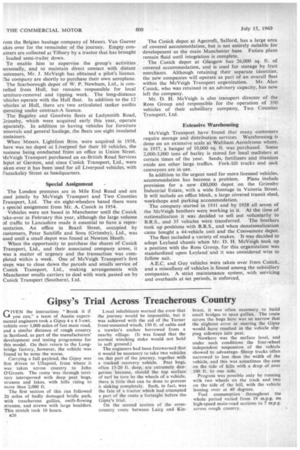Gipsy's Trial Across Treacherous Country
Page 60

If you've noticed an error in this article please click here to report it so we can fix it.
G1VEN the instruction: "Break it if you can," a team of Austin experimental engineers took a Gipsy 4 x 4 5-cwt. vehicle over 1,000 miles of fast main road, and a similar distance of rough country in Scotland, as part of the manufacturers' development and testing programme for this model. On their return to the Longbridge factory, ,however, the vehicle was found to be none the worse.
Carrying a full payload, the Gipsy was first driven to Ullapool, from where it was taken across country to John O'Groats. The route was through territory interspersed with deep peat bogs, streams and lakes, with hills rising to more than 2,000 ft.
The first section of this run followed 20 miles of badly damaged bridle path, with treacherous gullies, swift-flowing streams, and strewn with large boulders. This stretch took 10 hours.
B26
Local inhabitants warned the crew that the journey would be impossible, but it was achieved with the aid of the Turner front-mounted winch, 150 ft. of cable and a trawler's anchor borrowed from a nearby village. (It was found that the normal winching stake would not hold in soft ground.) The engineers had been forewarned that it would be necessary to take two vehicles on this part of the journey, together with a tracked recovery vehicle. Peat bogs, often 15-20 ft. deep, are extremely dangerous because, should the top surface of turf be torn by the wheels of a vehicle, there is little that can be done to prevent it sinking completely. Such, in fact, was the fate of a tractor which had attempted a part of the route a fortnight before the Gipsy's trial.
On the second section of the crosscountry route between Lairg and Kin brace, it was often necessary to build small bridges to span gullies. The route across. the bogs here was so narrow that the slightest error in steering the Gipsy would have resulted in the vehicle slipping sideways into peat.
Nowhere was the surface level, and under such conditions the four-wheel independent suspension of the vehicle showed to advantage. Sheep tracks often narrowed to less than the width of the vehicle, and this was sometimes the case on the side of hills with a drop of over 100 ft. to one side.
Progress was possible only by running with two wheels on the track and two on the side of the hill, with the vehicle leaning over at 40 degrees.
Fuel consumption throughout the whole period varied from 19 m.p.g. on high-speed main-road sections to 7 m.p.g. across rough country.




















































































































